The Symbolic Process and its Integration in Children
Chapter 6: Personal Pronominal Symbols and Symbolic Learning Curves
John Fordyce Markey
Table of Contents | Next | Previous
WE have been reviewing facts showing the action content in the child's symbols. The examination of the so-called first word as well as other facts indicate this action to be associated with persons. The child's existence is so closely connected with and dependent upon the people among whom-without his leave-he is placed, that symbols to designate others as well as himself are very early and useful acquirements.
Due to the peculiar habit of regarding proper names as " improper " for inclusion in the tabulation of children's vocabularies, the present data are restricted primarily to personal pronouns. They may be taken as one important criterion of the role of persons as such in the symbolic behaviour of the child. They also mark a more " personal " aspect of social relationships than has been achieved before their appearance.
In order to follow this inquiry, eight vocabularies were obtained from different sources. Each vocabulary begins with the first word, followed by a record of the new words added each month. They are listed in Table VIII and plotted in Graphs II-IX. On the graphs there are also indicated the personal pronouns and the time of the acquirement of them. An examination of the graphs shows a clear association of the appearance of the personal pronouns with high points in the appearance of new words. Considering only those months in which the data are relatively definite, we find that 78% of the months in which personal pronouns are acquired are associated with a rising curve and that over 85% of such months are associated with peaks or high rates of learning.
(
62)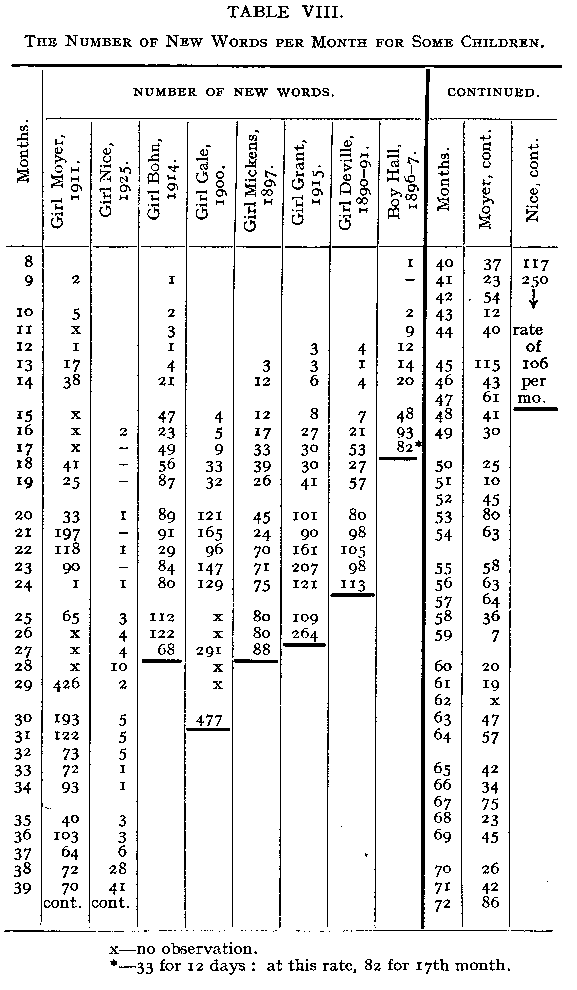
(63)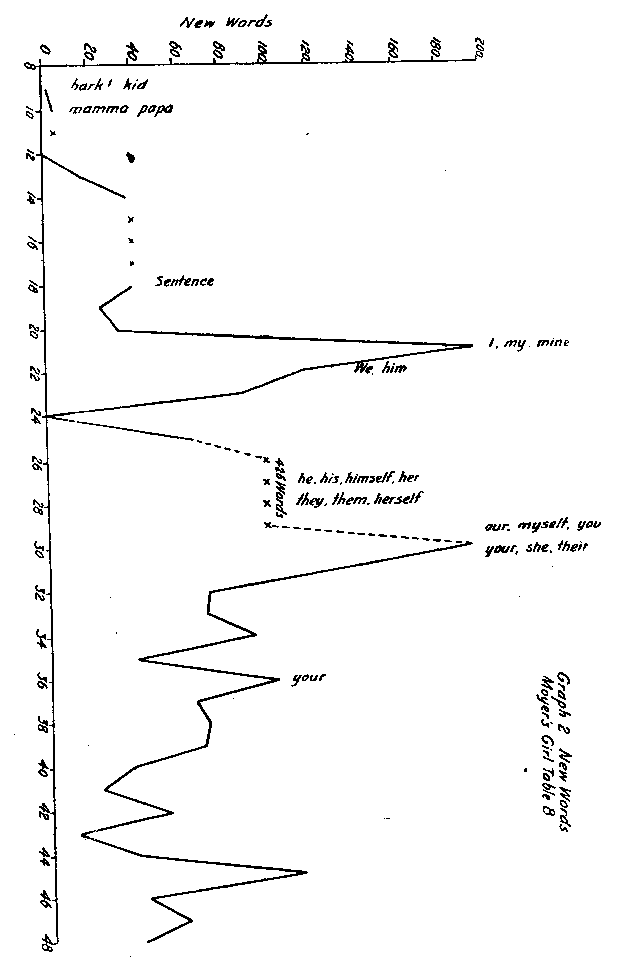
(64)
The graphs show that the learning curves are not steady, but have a marked tendency to fluctuate from crests to troughs. It would be very desirable to have other data of the child's activity in order to see how they would correspond with the word-learning curve. It would be
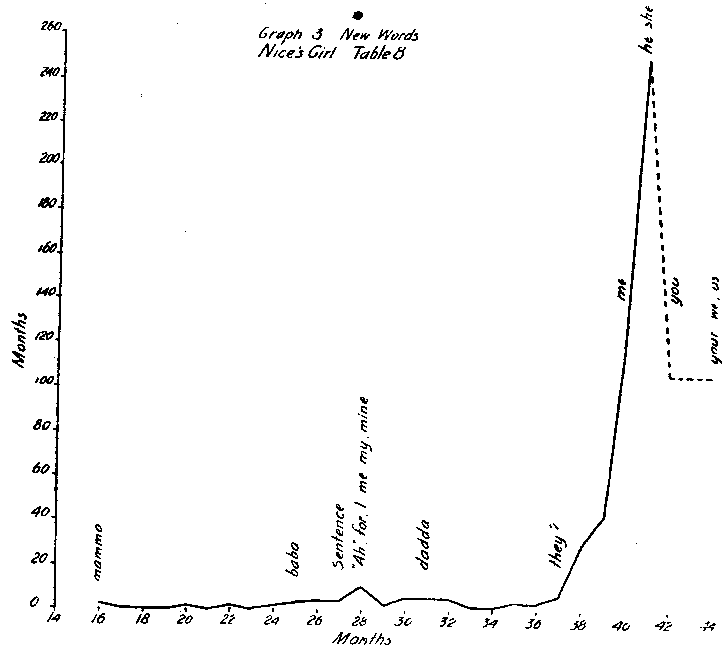
particularly instructive to compare gesture language with vocal language, but sufficient data are not available to do this. Mrs. Nice's child, during the long plateau period, used grunts and gestures. She pointed for food, and when hungry or thirsty, would open her mouth and point to it. It has been a common observation that learning to walk checks or defers language learning. This is probably
(65) due to the fact that walking is an act which can be carried out or completed by the child itself, not requiring a great deal of co-operative activity on the part of others. Such co-operative activity as there is does not necessitate many verbal responses on the part of the child in order to initiate it. The process of walking may also be quite absorbing to the child. Some types of motor activity would undoubtedly show a positive correlation with word acquirement. Watson (1924) has discussed some aspects of the parallel development of motor and speech responses. Judging from the vocabulary curve of Moyer's child, the crest of rapid learning is passed during the third year of life. The other cases are not for a long enough period to be decisive either way, except to show that there would be a considerable amount of individual variation in this as in other respects. Figures which Smith (1926, p. 54) gives for 273 children, showing the gain during each six months, show the greatest increase between 2 : 6 and 3 : 0 The figures are
| 0 : 6 — 1 : 0 | 3 |
| 1 : 0 — 1 : 6 | 19 |
| 1 : 6 — 2 : 0 | 250 |
| 2 : 0 — 2 : 6 | 174 |
| 2 : 6 — 3 : 0 | 450 |
| 3 : 0 — 3 : 6 | 326 |
| 3 : 6 — 4 : 0 | 318 |
| 4 : 0 — 4 : 6 | 330 |
| 4 : 6 — 5 : 0 | 202 |
| 5 : 0 — 5 : 6 | 217 |
| 5 : 6 — 6 : 0 | 273 |
The graphs show a slow or plateau-like start and later a rapid rise in the new word curves. Usually associated with the beginning of this first rapid rise is the first sentence, as shown by the graphs. The first sentence, judging by these graphs and other sources,[1] occurs around
(66)
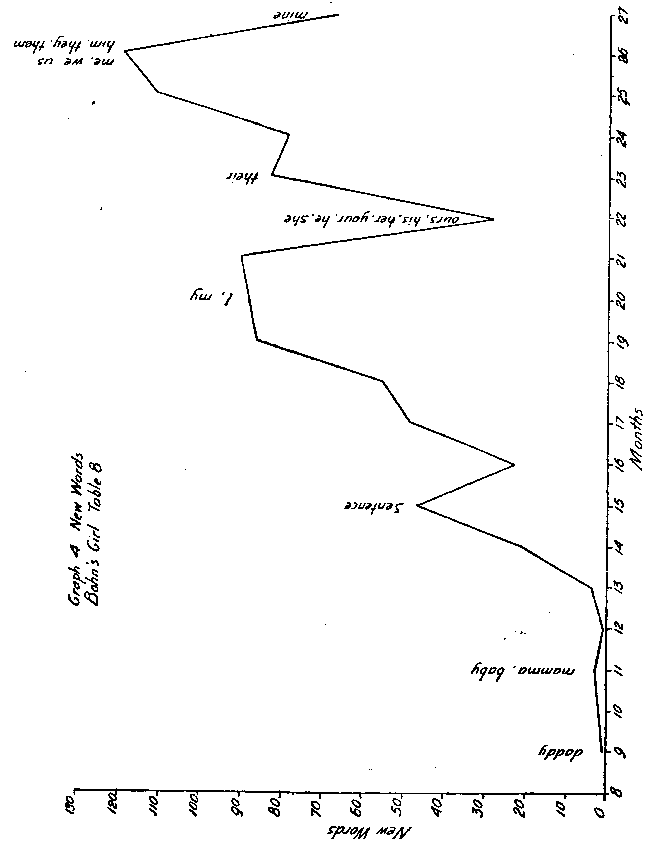
(67)
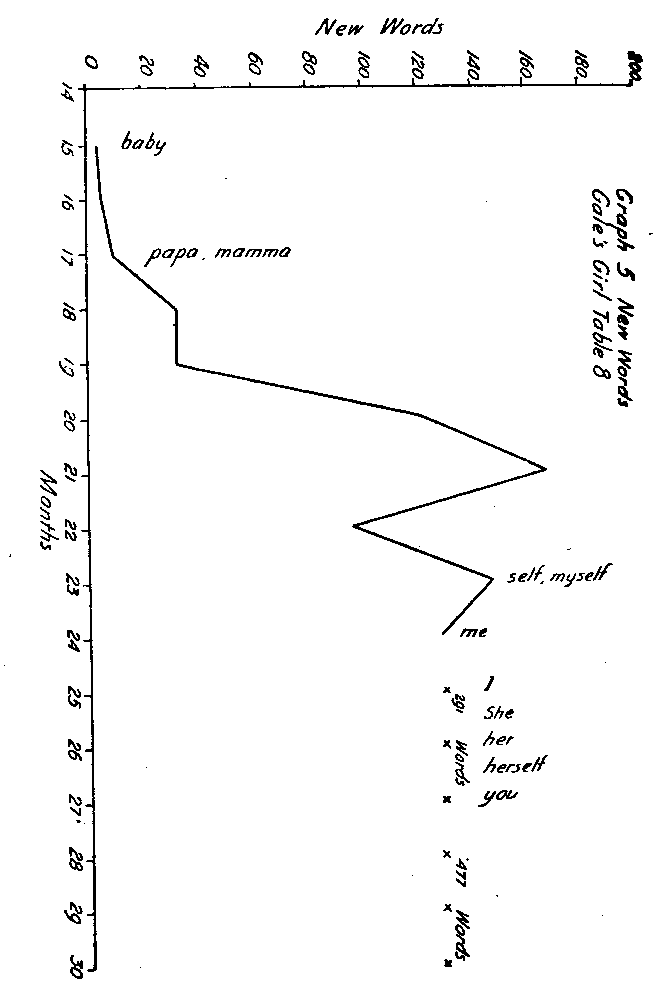
(68) the seventeenth month. Koffka and the Sterns say it is about the eighteenth month that the child begins to ask for names, " What 'at ? " and the like. They regard this as a significant point in the child's development.
In so far as we can make an inference from the data available, it would seem to be about or a little before this time when the true language symbol appears. The first genuine sentence, if put together by the child, would mean that symbols were present. It would require an integration in the child's behaviour of separate acts and objects which would necessitate symbols. Of course, it is probably true that some of the so-called first sentences are only parrot verbalizations as are the first words, but these cannot be called true sentences. Also the child's behaviour in asking names shows that symbolic integration is quite well started in its beginning. The beginning rapid rise in the curves are further evidence of a change in the process. However, this appearance of symbols is not to be thought of as an overly sudden development. Word conditioning has been going on for some time.
This conclusion regarding the appearance of the first real symbols at about the seventeenth or eighteenth month was drawn before going into Stern's own study in this connection. It was interesting to find how closely his conclusions concerning the appearance of the first real symbols at 18 months coincided with the above (1907, 1924 Sec. III). In regard to these early symbols, Stern says that the earliest spontaneous remembrances spoken of by Hilde (18 months) referred exclusively to objects, principally persons (1924, p. 378). The differentiation of action, particularly the child's own, a little later (19 months in Hilde's case) is not evidence as might be assumed from Stern's account that these first objects are not action objects. They would be action objects ordinarily in a double sense, due to action on the part of the child and also action on the part of the object, which is generally a person. In the light of all the evidence at hand, it would be hard to show how they could be otherwise
( 69)
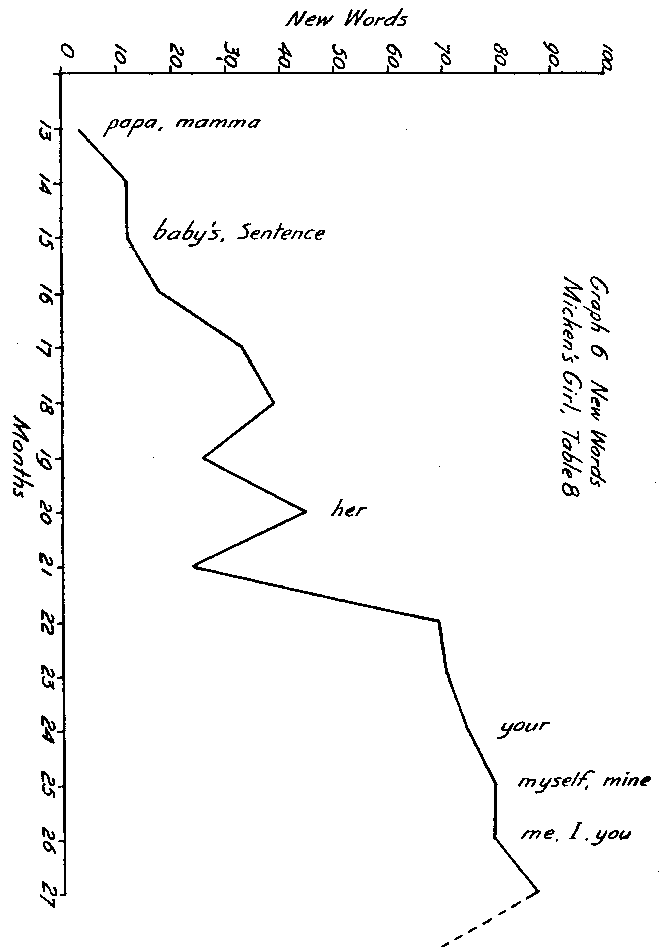
(70)
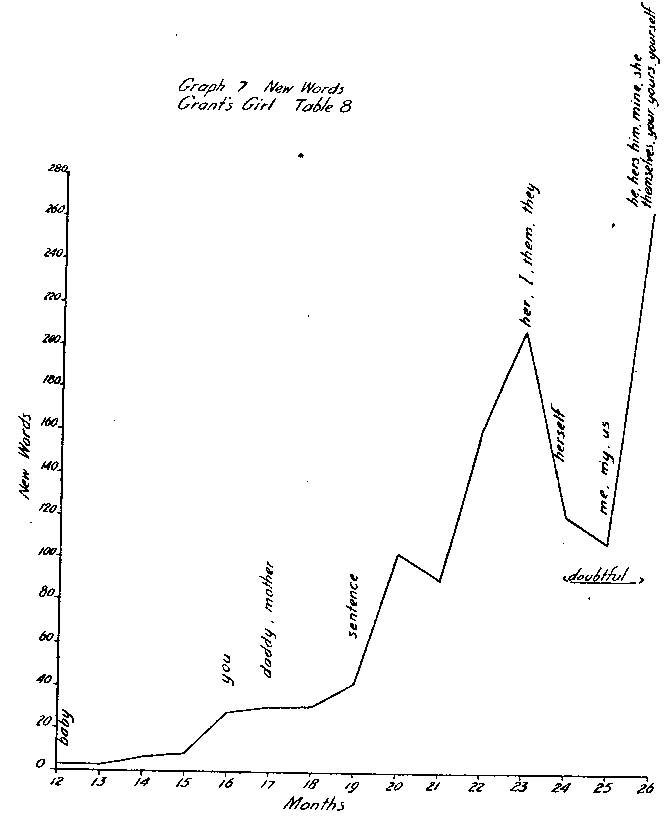
(71) than action-objects.[2] To take them as indicating a substance-stage as distinguished from an action-stage seems quite unwarranted. Beginning with such acting objects, the child with more experience becomes able to symbolize actions more distinctly than before, hence greater differentiation develops in this direction. This indicates greater integration, but not a change from a non-action-stage to an action-stage.
As the cases generally studied by child psychologists seem to be somewhat more precocious than the average, the period in which true symbols arise would probably be later for the child population in general. It would be earlier for exceptional children. Such allowances as this must be made for most of the conclusions made regarding periods or stages of developinent. This, however, does not invalidate such conclusions ; it means that variations may be expected in the application of such generalizations to particular cases. In this connection it is interesting to note that in a study carried on by Muntz in connection with the Yale clinic, Gesell (1925, pp. 217 seq.) reports for 5o supposedly normal and representative 2-year-old children of the community in English-speaking homes and of American parentage, that 2o, or 40%, used mere words, and 30, or 6o%, used sentences. It is probable that these figures cannot be taken without reservations on account of the small amount of check by the observer. It is likely that some of the 40% had used and were capable of using sentences. Nor does the study determine the time of the appearance of the sentence ; thus it might be found that in these cases the average time of its appearance was some months earlier, as is indicated by other observations.
In order to discover which pronouns were acquired first, the list of pronouns were taken in the order in which they were given by the observers. Where several were acquired during one month, some error may be introduced by this procedure. However, from the records it seems that the words were listed in the order in which they occurred during the month. Thus it would be valid to take the
( 72)
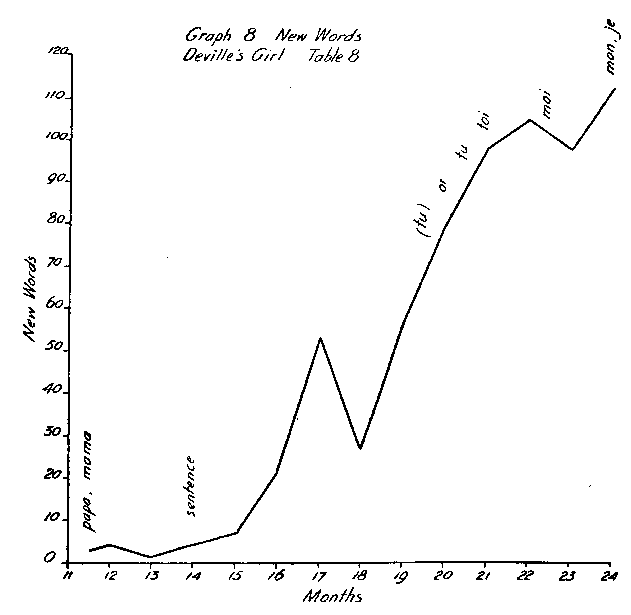
(73)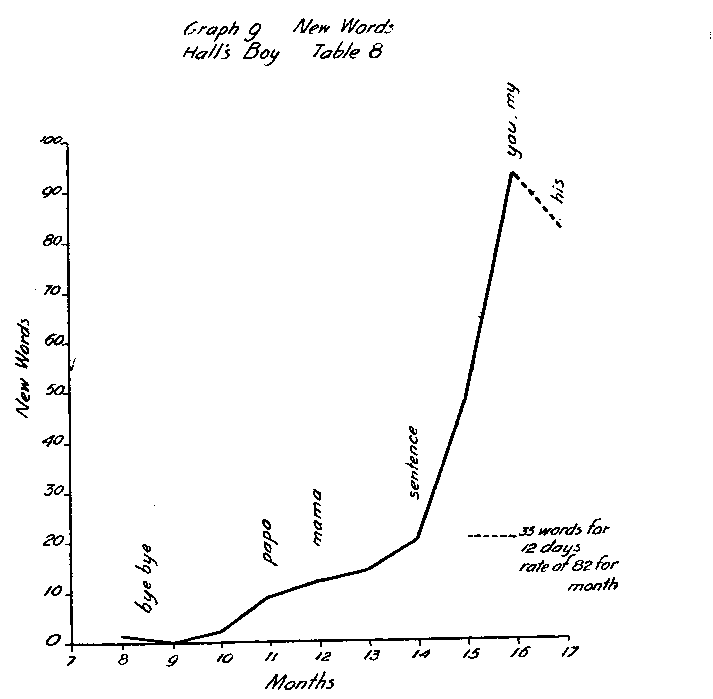
( 74) listed order as the true order of their appearance during the month. When only one pronoun is learned during the month, which happens fairly often, the chance of misjudging its sequential order would be eliminated. This would hold true particularly for the first pronouns acquired, such as " I," " Me," etc. However, four out of the nine cases considered are daily tabulations, and a fifth case has the pronouns numbered in the order of their appearance. This would eliminate the risk of such an error for these cases. The nine cases include seven of those already given and two from Gheorgov (1905). The data for Moyer's child were not included on account of the fact that, although he gives the monthly order of appearance, the pronouns are not listed according to their appearance during the month.
It might also be stated that keeping a record of a child's talk from day to day is a tedious task, with. chances for interruption. These nine cases are probably the most accurate observations which we have up to the present.
The results are given in Table IX. They were obtained by weighting the pronouns in each case according to the time of appearance. The last one to appear was weighted i, the next to the last 2, etc. The first one to appear would thus receive the greatest weight. Having thus weighted the pronouns, for each child, the total weighting for any pronoun was obtained by adding together all of the individual weights for that pronoun. Thus, if, for three children, " themselves " appeared last, it would be weighted 1+ 1 + 1 = total 3 ; if it appeared last for one child, next to the last for another, and third from the last for the other, it would be weighted 1 + 2 + 3 = total 6. The number of vocabularies in which a pronoun occurred is indicated under frequency. The reason for only nine occurrences of " I " and " Me " is due to the fact that Mrs. Hall's child was included, for which data were given to the 500th day only. Just three pronouns were present, and these were exceptional in that neither
" I " nor " Me " was among them. Mrs. Hall states
( 75) that the first pronouns, although used correctly, were not used frequently or independently.
The data of Table IX are summarized in another form in Table X, where they can be more readily analysed.
| TABLE IX | ||
| The Order of the Appearance of Personal Pronouns | ||
| Pronoun | Weight | Frequency |
| I | 75 | 8 |
| You | 60.5 | 9 |
| Me | 48.5 | 8 |
| Myself | 37 | 5 |
| Him or her | 35 | 4 |
| My | 34 | 5 |
| Your | 26.5 | 6 |
| He or she | 23 | 4 |
| Yourself | 22 | 4 |
| Himself or herself | 22 | 3 |
| Mine | 19.5 | 5 |
| His or hers | 18 | 4 |
| We | 17 | 4 |
| Our | 15 | 2 |
| They | 14 | 2 |
| Them | 14 | 2 |
| Us | 12 | 3 |
| Their | 11 | 2 |
| Themselves | 3 | 1 |
| Ourselves | 2 | 1 |
| TABLE X. | ||
| The Order of the 1st, 2nd and 3rd Personal Pronouns | ||
| 1st Person | 2nd Person | 3rd Person |
| I | ||
| You | ||
| Me | ||
| Myself | ||
| Him or Her | ||
| My | -- | -- |
| -- | Your | -- |
| -- | -- | He or she |
| -- | Yourself | -- |
| -- | -- | Himself or herself |
| Mine | -- | -- |
| -- | -- | His or hers |
| We | -- | -- |
| Our | -- | -- |
| -- | -- | They |
| -- | -- | Them |
| Us | -- | -- |
| -- | -- | Their |
| -- | -- | Themselves |
| Ourselves | -- | -- |
(76) It hardly seems justifiable to include in the above computations random observations regarding the appearance of the pronouns. Even serious attempts such as those given above are sufficiently subject to error without introducing other more or less casual observations. However, the following cases from Germany and Poland were taken from Gheorgov's summary to check against the above results. These cases included seven German children observed by Preyer (one), Linder (two), Ament (one), Frau Friedmann (two), and Frau Baronin (one) ; and one Pole observed by Oltuszewski. They appeared on casual examination perhaps contradictory. It is possible that language differences might change the result. However, a summary of these is corroborative rather than contradictory of the above results. The pronoun " mine " gets a considerably more important place. But in regard to these observations, Gheorgov criticizes some of them very severely, and particularly those connected with the high rating of the possessive " mine." From Table IX it appears that " mine " could easily be moved to a higher place and still leave the results very much the same, comparatively. Thus, while these random observations cannot be included, they appear to be positive rather than negative with reference to the previous data. It would be instructive to make a behaviouristic comparison between different language groups regarding the personal pronouns if materials were available. Pronominal learning might appear somewhat differently in French and English, for example. In the Table already given, only three languages are included : six English children, two Bulgarians, and one French child. These are hardly sufficient for an adequate comparison, but such a comparison would probably leave unchanged the main factors as pointed out (PP. 77 ff). And while it must be kept in mind that the addition of other data might make changes, it is probable that these changes would only be minor ones and would affect only in a minor way the conclusion drawn from these data.
There is a marked tendency for
( 77)
1. The personal pronouns to appear in the order 1, first person ; 2, second person ; 3, third person.
II. The singular pronouns to appear before the plural pronouns in general and for each series. Gheorgov's material substantiates this for the second person " you." It is given in both singular and plural forms in Bulgarian.
III. The subject-pronoun to appear before the possessive pronoun in each case.
IV. The pronoun ending in " self " or " selves " to appear late in each series ; i.e., in the first person singular, first person plural, etc.
V. The subject " I," " we," and "they" to appear before the object " me," " us," and " them." A. This is probably true for the second personal pronoun " you," but cannot be decided for these data because of the double use of " you" as subject and object. The subject "you" appears before the object " you " for Gheorgov's data, although the time between is relatively short.
B. The instance of the object " him " or " her " before the subject " he " or " she " is probably due to the fact that the child is used to having himself referred to frequently in the objective case as "him" or "her."
The outstanding feature of these observations is the appearance of the pronouns which designate persons as subjects before those which designate persons as objects or with possessive reference. Now the important question is, What is the significance of these speech reactions in this respect ?
The first and correct answer is that there must be more careful research before we shall be able to determine with desirable certainty.
It has been observed that children, when first learning personal pronouns, may get them mixed. A child may say, for instance, " You gave it to her," or " You went
( 78) walking," and the like meaning itself in both cases ; or it will say " I " meaning " you." However, this sort of mistake is not surprising. On the other hand, children do use these pronouns correctly and these mistakes must not be overemphasized.
The facts above, showing that the later pronouns also follow this same order--subject, object, and possessive forms-lend support to the supposition that the child designates himself " I " as a subject before he designates himself as an object or as a possessor in so far as the pronominal designations are concerned. This order of the acquirement of the personal pronouns quite probably indicates the actual order, although not the beginning, of the integration of the self in its relation to others.
It would, of course, be quite naive and illegitimate to claim, as some have done, that the first integration of the child as a self arises only with the first personal pronoun. As soon as the first real symbol appears there must be some sort of personal differentiation involved in the behaviour of the child, particularly if the social factor is as important as has already been indicated. Even before the first symbol the child in his habits of adjustment has established a basis in action for such a differentiation of himself. He already has a " parrot " name for himself and begins some symbolic self-reference when the self and symbols have arisen, before the pronoun " I " appears.
It must be insisted upon that the mere appearance of one pronoun or another is not the real point ; it is only, as these pronouns indicate other facts and conditions of social experience, that they are significant. Thus, concerning the first personal pronoun, it is the designation by the child of itself as in an active state which is important. And this use of the " I " to indicate the acting child is the significant aspect pointing to a behaviouristic content of this primary self symbol. In such an active organism other aspects of the self and personality are later integrated and symbolized. It is probable that whatever self name or whatever self pronoun appears first is used predominantly in this self-acting reference and that the " me," or
( 79) more passive self, develops later as a differentiation of this primary self as indicated by our data.
Some other facts also point to the significance of the early appearance of " I " in these cases. It has been noted by observers that first-born children do not use " I " until late. Older children seem to stimulate the younger child to acquire this pronoun early and to use it quite correctly (Stern, 1924, p. 157). At least four of these children, a child of Gheorgov, of Deville, of Bohn, and of Grant, appear to be the first or only child. Mrs. Hall's evidently was an only child, but it lived for a time at least with other children. The data are incomplete concerning Micken's child, but it is probable that it had association with children. The three other cases are those of later children. Thus with these only children included in the computation the " I " pronoun ranks first. Gheorgov thinks it quite significant that " I " appeared first for both of his sons in spite of the fact that Bulgarians have a tendency to leave off the "I" pronoun in speaking.
The appearance of the subject reference before the possessive reference also probably indicates a significant situation. There are conflicting observations regarding the early possessive habits of the child. Watson's work on children goes to indicate that there is not much in the way of a possessive instinct. Any sort of inherent propensities which a child might have would seem to be comparable to those of other animals which constitute a rather slim outfit. From this genetic viewpoint, there is little evidence for presuming much of a native basis for possessive habits. The more fundamental are the manipulative acts and those pertaining to the consumption of things. A young child is much more apt to destroy, throw away, or to stick into his mouth and try to eat than to keep as a possession. Judged from these facts, it would seem natural that the subject " I " should develop before the possessive " my " or " mine " as our data indicate. This would seem to show that our general possessive activity is based upon an earlier development of the social
(80) " self " and that they are consequently built up and established by social training and inculcation. This, however, is a problem for further research.
From the summary it will be noticed that " you " also appears very early. If the explanation of the integration of symbols given in Chapter III is correct, this early appearance of " you " would also be expected in addition to the other more specific designations for persons. The
" I " and " you " are evidently very closely connected.
The average time at which the " I " appeared was about the end of the 23rd month. The " you," on the average, appeared about the end of the 24th month. In this connection it is instructive to compare the appearance of the pronouns with some of Stern's conclusions. His first period of language development is from 12 to 18 months ; the second is from 18 to 24 months, in which true symbols develop rapidly ; the third period is from 24 to 30 months, during which the child learns inflections and finer shades of expression. At two years, he says, words being " to live, to bend, to move " (1924, p. 165). As indicated, it is also at the second year mark or a trifle before, according to the data analysed here, that the personal pronouns appear. It is probable that the explanation for the beginning of this new period is to be found in the greater differentiation produced by social activity. A more " personal " integration in the child's behaviour, effected by social contact and interaction, has served to set his " self " off more clearly from " others," to mark his acts off from the acts of others. What he is doing becomes more definitely separated from what others are doing. For illustration, instead of " Mamma-eat," it becomes more clearly distinct as " Mamma gives breadBaby eat," " Mamma eat-Susan eat," and the like. Social contacts and experience also serve to differentiate acts which are past from present acting, and also from future ones. Not that there is a clear time sense, but there is some sequential differentiation in one direction or another. Such a social integration would lay a basis in
( 81) experience for the acquirement of the personal pronouns, inflections, and the like.
Another way of getting at the significance of the pronouns is the actual use which is made of them by the child in his social life. This will be a main consideration of the next chapter.